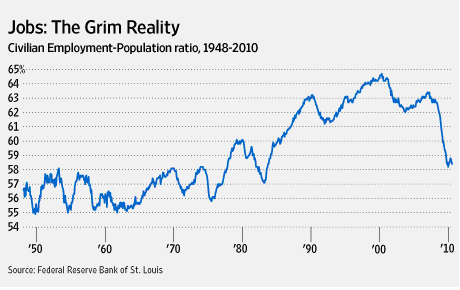- Know thyself
- It’s so high, you won’t believe it
-
My favorite unemployment
investment
Today’s letter has very little to do with an explicit
commodities opportunity, but it has EVERYTHING to do with how you should be
investing today.
If I could condense my investment thesis into a single
sentence, it would be “Boil down the markets into the simplest possible
terms, and invest accordingly.”
It’s a strategy cribbed from the world’s best investors such
as Peter Lynch, Warren Buffett and Jim Rogers. But that’s not why I keep it
simple. I keep it simple because it cuts down on the amount of time I would
waste researching unnecessarily complicated investments.
For instance, I
know very little about the prescription drug business. Johnson and
Johnson (NYSE: JNJ) might have the greatest pipeline of
revolutionary life-extending drugs in the world, but I’m not a student of
bio-chemistry. It would just take too much time for me to do the research on
each of their drugs, let alone the standard balance sheet due
diligence.
Couple that kind of extensive research together with the
uncertainty of Obamacare’s unknown variables, and I don’t know how anyone can
come to a salient conclusion about a single company in the healthcare
sector.
It would take me too long to boil these uncertainties down
into something even approaching an accurate investment strategy, in other
words.
But some sectors are much simpler to understand, and
therefore, act on.
Like employment.
Labor is one of, if not the biggest, cost factor for any
given business. It’s vital to understand the labor markets – and until all
companies are run by robots and computers, it will remain important to look
at employment numbers. You need to understand how labor fits into the
equation for any investment you make. Just like oil, labor is one of those
factors that you ignore at the peril of your investment success.
So when I see the Bureau of Labor and Statistics telling me
that unemployment is currently at about 9.5%, I’ve always wondered: what
about the people who aren’t looking for jobs?
I want to boil those two numbers together, because for me,
the REAL unemployment number is, by definition, the proportion of working-age
adults who aren’t employed. But the BLS has a unique and somewhat
self-serving way of defining unemployment:
“People with jobs are employed.
People who are jobless, looking for jobs, and available for
work are unemployed.
People who are neither employed nor unemployed are
not in the labor force.”
You’re considered “not in the labor force” if you don’t want
a job, and you haven’t been looking for a year.
Frankly, the distinction is utter nonsense. If you’re not
employed, you’re unemployed – it’s just that simple.
The reason I care to make this distinction is because it’s
vital to understand what’s going on in the labor markets if you’re going to
be a responsible investor and make rational decisions based on accurate
numbers.
To say that we have 9.5% unemployment is simply a lie.
That’s just 14 million people out of work. Unemployment, by any sane,
rational definition is currently much, much higher than the government would
have you believe.
According to a recent story in the
Wall Street Journal, the real employment number, otherwise known as the
civilian employment-population ratio, is currently at about 59% – which means
that the unemployment number is about 41% – which accounts for an additional
82 million people.
That’s right, about 41% of working age adults in
the United States currently are not working.
They’re “not-employed” to coin a new phrase.
So, now that we’ve condensed these numbers into something we
can understand…what are the investment implications?
First, I’d like to disabuse any devil’s advocates of the
notion that some portion of these people aren’t looking for jobs because
they’re independently wealthy.
There’s no line in the monthly adjusted BLS employment
report that denotes such a population of people, but there is a category
which denotes that there are currently 699,000 people not in the labor force
for “other” reasons, which includes a “small number for which reason for
nonparticipation was not ascertained.”
Let’s assume, for the sake of argument, that 349,500 of
those people are independently wealthy, and are not working because they
simply don’t need to.
That’s still a total of about 97.5 million people that are
currently not working.
If that number doesn’t scare you, I don’t know what will.
41% of this country’s population is in seriously dire straits.
Not to make this Monday morning any more of a bummer, but
when I look at these numbers, I get the inclination to invest in firearms
manufacturers.
My favorite gun company is Sturm and Ruger (NYSE:
RGR). I currently own and regularly shoot one of this company’s most
popular firearms. This gun is also one of the most popular firearms for
self-defense: the .357 magnum revolver.
For years, this gun was the staple service revolver for law
enforcement. It’s been usurped by semi-automatic pistols like the Glock 9mm.
In a pinch, you can use this gun to hunt with as well. Elmer Keith, an Idaho
rancher, gun enthusiast and hunter claimed that this gun could take down any
animal in North America.
Today, you can buy shares of Sturm and Ruger for just under
nine times earnings. The company also pays a fair-sized dividend yield of 3%.
The company has a 20 year history of paying dividends.
I’d suggest buying this company as long as it’s selling for
under $14 a share. That lets you buy this company at less than 10-times
earnings, which is statistically a very conservative buy-price for most
sectors of the stock market.
Good investing,
Kevin McElroy
Editor
Resource Prospector
Full disclosure: no positions as of this writing
 Facebook
Facebook
 Twitter
Twitter
